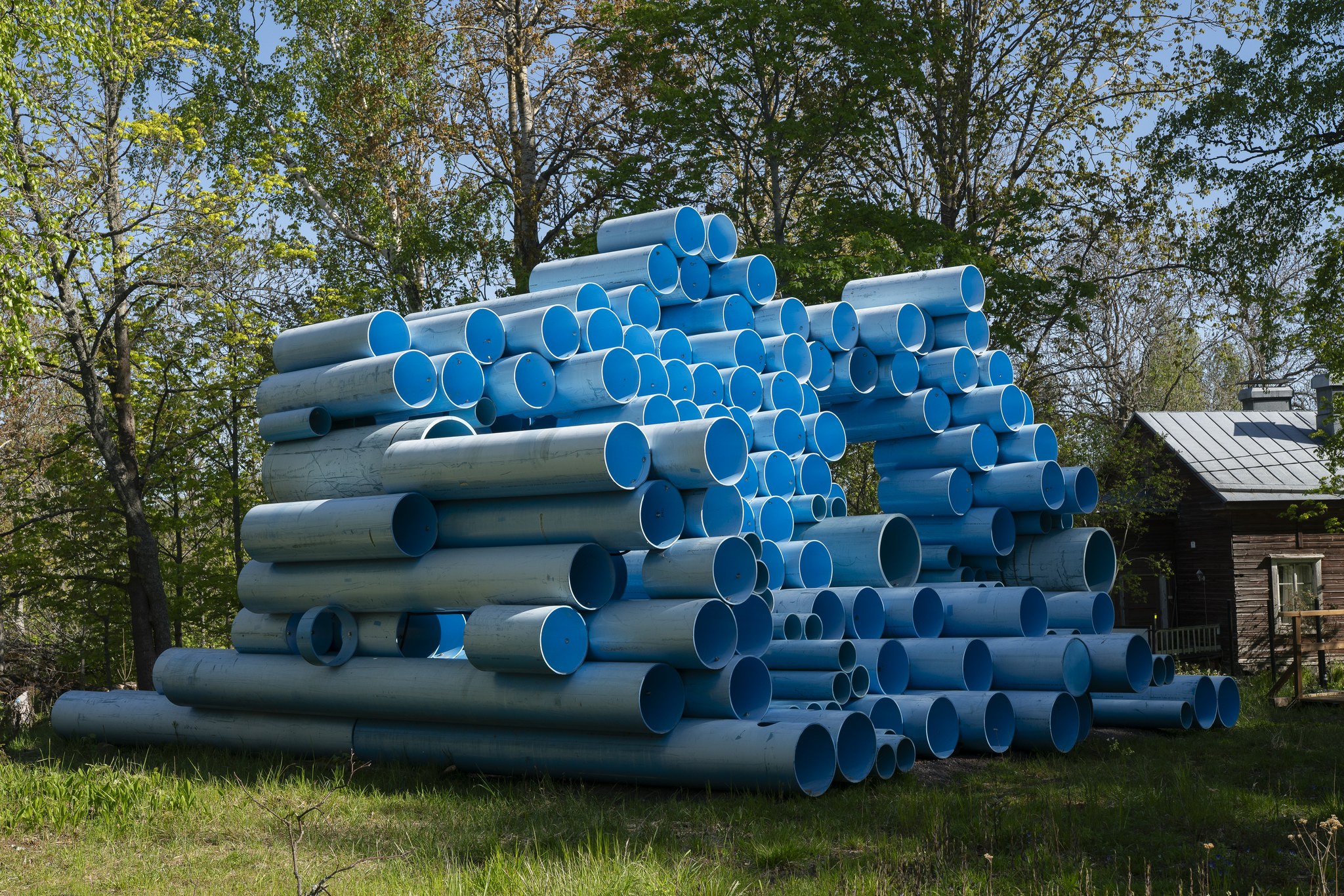Nomeda Urbonas (b. 1968) and Gediminas Urbonas (b. 1966) are Lithuanian-born artists based principally in the United States.
Gediminas Urbonas is an Associate Professor in Art, Culture, and Technology programme at the Massachusetts Institute of Technology (MIT), where Nomeda Urbonas works as a research affiliate.
As co-founders of Urbonas Studio, they collaborate both as artists and educators. Through diverse nodes of knowledge production, they strive to foster new ways of thinking and novel forms of transformative collaboration.
Photo: Berta Tilmantaitė

Nomeda & Gediminas Urbonas: Futurity island, 2018-25. Helsinki Biennial 8.6.–21.9.2025, Vallisaari Island. Courtesy of Blackwood Gallery. Photo: HAM / Helsinki Biennial / Sonja Hyytiäinen
Futurity Island, 2018–25
Artwork location: Vallisaari Island
Comprised of plastic pipes used for draining peatlands, the installation on Vallisaari Island, designed in collaboration with architect Indrė Umbrasaitė, transforms a former instrument of environmental subjugation into a platform for interspecies communication. Ultrasonic transducers installed inside the plastic structure transform the sculpture into a learning environment in which we hear the normally silenced voices of other-
than-humans, notably insects.
The first version of the installation was presented in the Canadian city of Mississauga, where the artists collected soil toxicity data and recorded the sounds of hydropsyche larvae forming the basis of the original soundscape, composed in collaboration with sound artist Nicole L’Huillier. Hydropsyche is a genus of caddisfly that serves as a useful bioindicator of water quality and purity.
The installation’s tubular structure evokes the life cycle of caddisfly larvae, which build tubular shells by secreting a silk-like substance and using reinforcing materials such as small twigs, grains of sand, and other available detritus. The tubular casing enables the larvae to forage for food by providing protection against predators.
The protein structure of silk excreted by the caddisfly larvae is currently being studied for potential applications as a waterproof adhesive. At MIT.nano the artists collaborated with materials scientist Markus J. Buehler, who developed a system where sound is used to interpret the structural properties of larvae silk protein. The resulting sound samples are woven into a new sonic fabric for the second edition of the Amphibian Songs soundscape released at Helsinki Biennial 2025.
The artwork production is supported by National Endowment for the Arts, MIT CAST, UTM, and IPEX.

Gediminas Urbonas: Unmelting Black (Snowman 1:1), 1995. Helsinki Biennial 8.6.–21.9.2025, Esplanade Park. Photo: HAM / Helsinki Biennial / Henni Hyvärinen.
Unmelting Black (Snowman 1:1), 1995
Artwork location: Esplanade Park
Gediminas Urbonas’ artwork Unmelting Black (Snowman 1:1), made of Karelian black granite, was originally produced for the ARS 95 exhibition of the Museum of Contemporary Art in 1995. It was situated in front of the Ateneum building, standing in a queue with other visitors to the exhibition. The work was acquired by the City of Helsinki and placed in the Koulupuistikko park on Korkeavuorenkatu until it was moved to its current longterm home in Pikku-Huopalahti. During Helsinki Biennial 2025 the snowman will temporarily visit the Esplanade Park.
Gediminas Urbonas described these earlier series of works of his – many of which were meant to be shown as public art – as ‘object/artifact archaeology’. The sculptures have retained the shape of the original artifact that has given them their form, but the new material chosen for them transforms their original use dramatically.
With this body of work Gediminas Urbonas studies our conceptions of our everyday surroundings; he extracts something from it, transmuting it into a sculpture to see what mythical dimensions it can attain in its modified state. One of these experiments is the weather resistant black granite snowman. Seen now in a busy downtown park, it is a snowman that never melts and instead of a pristine white snow figure, this snowman is sturdy, black, and shiny. It echoes the lost winters amid the climate change and global warming here in Northern Europe. The ‘unmelting’ snowman keeps its form and figure despite the sun and heat, while also carrying on its surface the color and shininess of petroculture.